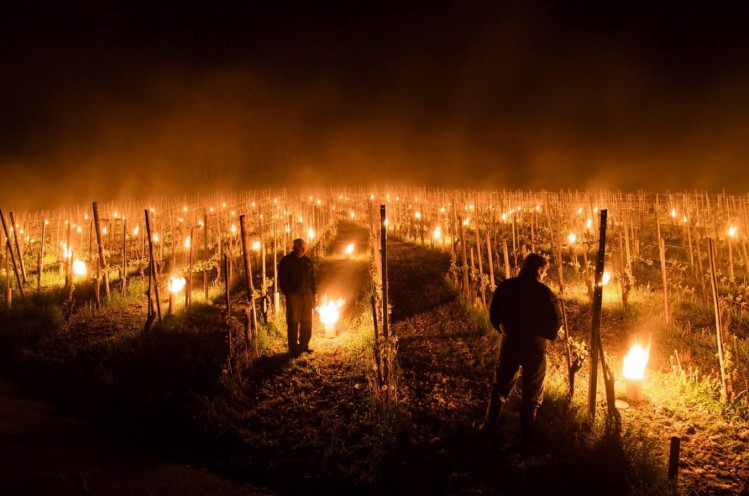2016
This year, at the very end of September we have finished harvest season by picking Rhein Riesling from our highest plot. Fortunately, we arrived just in time before the ugly autumn weather hit us. Moreover we had a hard time with birds, starlings this vintage. Thus leaving the fruit out in the vineyard to ripe would have been daring not only because of the weather conditions. So we are through an immensely challenging vintage. 2014 was equally tough on us, so this makes me wonder: will every even year be like this?
In January 2016, it was quite cold but by the end of the month when we started pruning it got up to 15°C. February was mild as well, but with unusual amount of rainfall. Our almond trees on the south side of the Szent György Hill started to blossom exceptionally early on February 23. By March the rains have stopped, the month was really warm and windy. After vintage 2015 we have experienced yet again a record-breaking heat wave. We finished the pruning wearing T-shirts.
Chenin Blanc after budbreak
In April the mild, windy spring weather continued, until one morning we have noticed rock-hard ice shield on our cars. When I went out to check the condition of our plots I noticed some shoots have been burnt by frost. This was in our Pinot Noir plot which lies the lowest on the hill. I didn’t know then, that this was only the beginning of the catastrophe. On April 26, 70% of our Pinot Noir vines have been strongly damaged by frost. The cold wave with -2 °C has burnt some of our highest plots as well, but not so severely.
According to the elderly who live in the region they haven’t experienced such a weather ever since they were born. The sad event made us wonder how to resolve this threat in the future. The ruthless frost has also hit other parts of Europe like Champagne, Burgundy, Austria and Switzerland. This photo was taken in a Swiss winery, where they stayed out all night tending the fires to keep the cold air coming from the Alps from settling down on the vineyard. This event has taken us by surprise and unprepared. Do we have to get ready to fight even more extreme weather conditions in the years to come?
Frost protection in Gantenbein Winery, Switzerland
We have picked all the frozen shoots from all the damaged vines to protect them from fungal diseases. Unfortunately this has not helped their condition, we had to accept the forthcoming crop loss. A few weeks later after the shock, the vines started to push new shoots, but they mostly developed foliage. At the end of May and the beginning of June, downy mildew has intensified and the young shoots were not able to protect themselves. Furthermore the weather turned unusually cold and rainy, with around 12°C daytime temperature. This also affected the blossom, unfortunately we were not able harvest any Bakator grape, due to its complicated pollination. Because of the same problem we didn’t pick any Cabernet Sauvignon this year.
Due to our ongoing transition to biodynamic farming (Demeter certification) we experimented with very low amounts of copper in our sprays, which didn’t seem to do any good to the Pinot Noir this vintage. Even though we have suffered a lot of damage this year, we have also learnt a lot and gained more experience in plant protection. Although the frost and using restricted amount of copper we have managed to harvest good quality Rhein Riesling and Chenin Blanc.
The summer was rainy, almost tropical. This year downy mildew was intensive until the end of August, but powdery mildew was unimportant. In July we were hit by two hailstorms: the first wasn’t too bad, but the second got lethal. We were lucky enough to have some foliage left after the hailstorm of 120 kph. The leaves that we were left with looked like as if they were shot by thousands of bullets.
At the end of July, we suffered from a heat wave causing very high humidity, then black rot has appeared in lower parts of our plantations. This has no organic remedy at the moment, so we had to wait out the crop loss.
Our Rhein Riesling in 2016
The first part of September was warm and dry. The acidity level of the berries were high, phenolic components matured quite early this year. We started the harvest season on September 7 with the remainders of Pinot Noir. This was made into base wine for rosé sparkling wine. The crop which was selected by nature resulted in a concentrated wine which is at the moment in amphoras for ageing.
The Chenin Blanc which was planted in spring of 2014, had its first harvest on September 14. We experienced a huge drop in acidity levels due to the warm autumn. Unfortunately the clusters were very warm when they arrived to be pressed, but we hope you will not be able to tell this when tasting it.
This was our 4th vintage with Rhein Riesling. Compared to 2015 this year’s wines are even more focused with lively acidity and a moderate 12.2 vol.% alcohol level. We wish to make even better wine than in 2015.
Still hoping for the best!
/ Istvan Bencze /